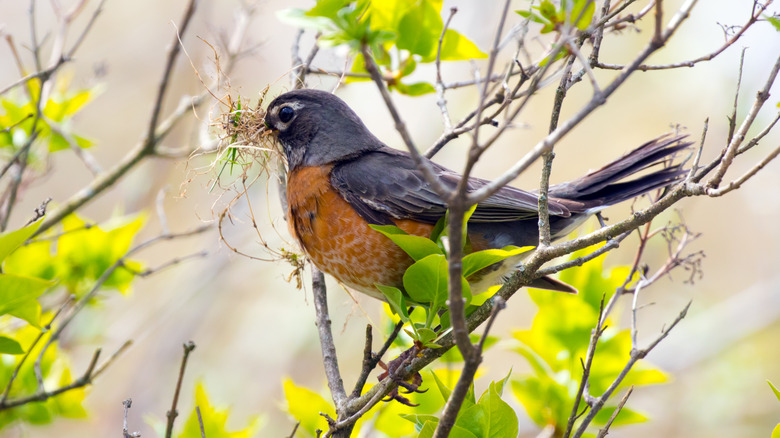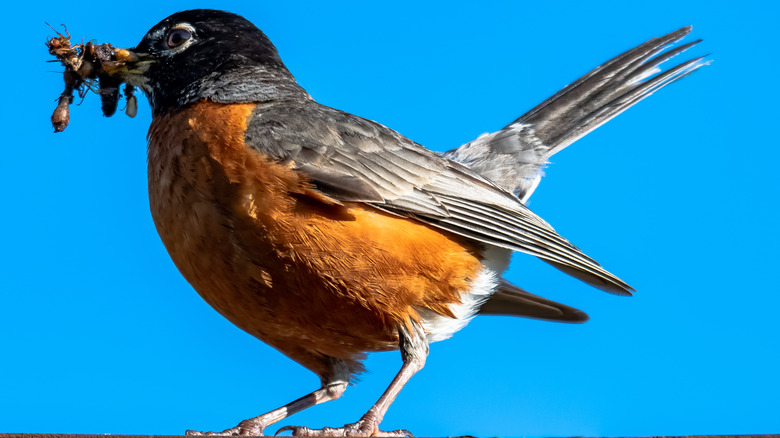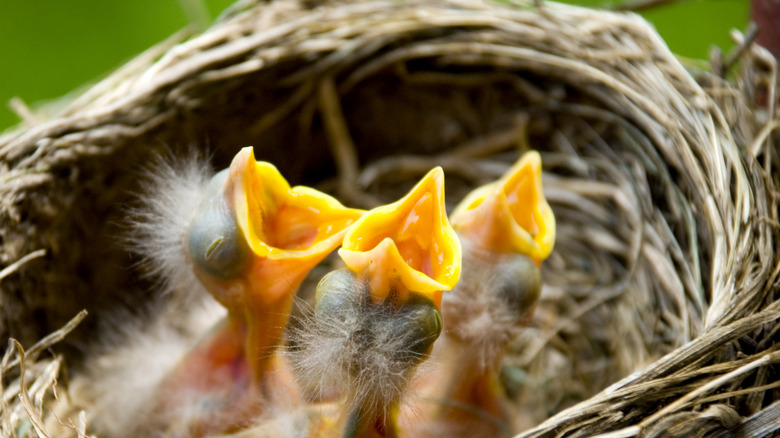How To Attract Robins To Your Garden
Celebrated in song, poetry, and nursery rhymes, the robin (Turdus Migratorius) is one of America's most popular and recognizable birds. It is the state bird of Connecticut, Michigan, and Wisconsin, and the English variety was recently voted UK's national bird in a landslide. Our version was first called "Robin" by the initial colonists in a sentimental nod to its English counterpart.
According to All About Birds, the robin is North America's largest thrush. An adult male can weigh up to three ounces and span eleven inches front to back. Once primarily forest-dwellers, the songbirds are now a fixture in populated open areas. Gardening Know How considers them easy to lure to one's garden. To ensure this early bird catches its worm in your garden is mostly dependent on doing this: You must offer an inviting and safe environment with a dependable food supply and clean water. Providing a suitable nesting habitat and nest supplies will also encourage robin visitors. Contrary to popular belief, their migration is often limited, so you can enjoy them in your backyard throughout the year.
Food to attract robins
Robins are omnivorous. They are renowned earthworm eaters. A robin cocking its head to locate its worm prey is a familiar backyard sight. Spiders, caterpillars, grubs, snails, and grasshoppers may also appear on a robin's menu, per Audubon. Letting your garden "go natural" can attract creatures that will, in turn, be a magnet for robins. An untended backyard, log pile, or compost heap is a paradise for worms, snails, and other robin delights, according to Woodland Trust. In the same vein, a robin will zero in on a pile of leaf debris, knowing it might be filled with insects and grubs. Placing a container filled with high-protein mealworms will also attract a hungry robin.
Fruit represents 60% of their year-round diet, up to 90% when fruit is readily available. The birds forage for fruit in trees and shrubs, so a garden with fruit-bearing trees and plants will lure them. Hawthorn, dogwood, chokeberry, bayberry, and crabapple work. So do mulberries, grapevines, pyracantha, cherry, and blackberries. Robins also prize spindle bushes for food and shelter.
Instead of a conventional seed-filled feeder, birders recommend using a fruit feeder to attract your red-breasted friend. The device can be suspended from a pole and filled with berries or other sweet delicacies. A fruit-filled plate on the ground will attract robins. Grape jelly might be irresistible too. Suet cakes, a high-in-fat wild bird food, will pique a robin's interest as well.
Robins will come to nest
Taking advantage of a robin's nesting period from April through August is key to attracting them to your property. Robins normally build their nests under building overhangs or use a tree or dense shrub to house the bowl-like structure. Attaching a nesting box to a tree or the side of your house will be a good substitute, provided it is sheltered, according to Cornell's Nest Watch. Make sure it is high off the ground, open in the front, and is sturdily mounted to thwart predators, particularly that curious neighborhood cat. A north or east exposure will protect it from the most intense sun and wind. In preparing a nest, robins will look for mud to line it. Filling a pan or trash can lid with dirt and water is a good way to attract a female robin looking for nesting supplies, says Wild Bird Watching. A robin might notice a pile of twigs, grasses, or even paper and come to your garden to claim them.
Learn Birdwatching advises making your nesting box look as natural as possible, with this exception: Topping it with a mirror might attract a robin who will be drawn to its own reflection. Robins also enjoy having a clean birdbath in your garden, even a heated one in winter. Don't let the thrashing unnerve you. Their bones are hollow, so they won't drown.


